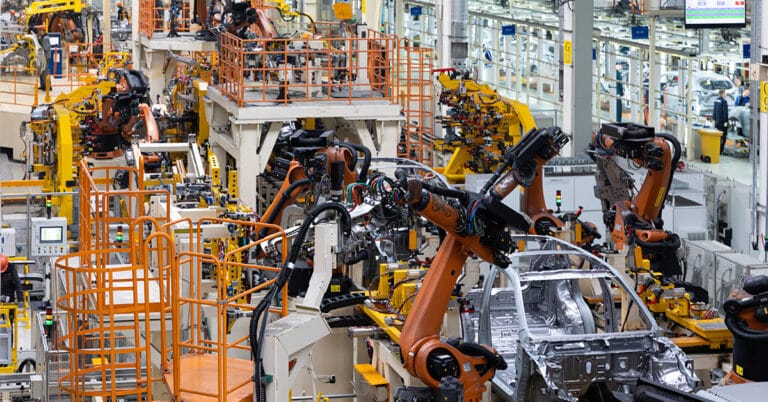Plant layouts impact everything from lead and cycle time to product quality, process repeatability, and overall cost. These layouts, also called “shops”, map the route taken by products through the manufacturing process.
When it comes to selecting a shop type, companies must consider both internal and external factors. For example, manufacturers experiencing sustained growth may experience SKU proliferation as new products are added to workflows. Those breaking into new markets, meanwhile, may encounter reshoring pressures coupled with increasing consumer pressure for cost-effective options.
Two commonly used layouts are job shops and flow shops. These approaches represent opposite ends of the production spectrum. While job shops focus on high-mix, low-volume production, flow shops prioritize low-mix, high-volume output.
Below, we’ll explore the basics of job and flow shops, highlight key differences, and offer insight on choosing the best-fit shop model.
What is a job shop?
A job shop focuses on the result of manufacturing processes — the job — rather than the individual steps involved. In practice, this approach means that production machinery is organized by function rather than in a linear sequence, allowing products to move through machines as needed rather than following a set path.
Job shops are ideal for handling high-mix, low-volume production: small-to-medium order volumes that differ in specification, design, or materials. Key characteristics of job shop layouts include make-to-order processes that allow product customization and flexibility in routing processes that ensure high-quality outputs.
It’s also worth noting that job shop models lead to variable takt time. Takt is a measure of the time it takes to produce a single unit. In a job shop, this time is not fixed; instead, it depends on the complexity of the design and the materials used. As a result, job shops rely on skilled labor to ensure high-quality production.
Industries that typically use job shops include aerospace machining, custom fabrication, medical device manufacturing, and MRO repair centers.
What is a flow shop?
A flow shop prioritizes repeatable production processes — the flow — to create identical outputs. Machinery is arranged in line or cell groupings, and the flow operates in one direction. Products move forward from one station to the next; unlike job shops, items never pass through the same machine twice.
Flow shops excel at low-mix, high-volume production, and large order volumes that require items identical in form and function. Flow shop products are made-to-stock using a fixed routing model that produces the same output every time. Takt time is balanced and consistent, and flow shops naturally lend themselves to production automation because routing flows do not change.
Sectors such as automotive fabrication, consumer electronics manufacturing, and fast-moving consumer goods (FMCG) often use flow shop layouts.
Job shop vs. flow shop key differences
Job shops and flow shops exhibit distinct differences in key performance indicators (KPIs) and core processes. Consider KPIs such as lead time, machine uptime rate, and overall equipment effectiveness (OEE). Lead times for flow shops are generally shorter due to their consistent production paths leading to uniform results. Conversely, job shops might achieve higher machine uptime rates, attributed to their lower batch volumes. OEE is harder to quantify since it combines availability, performance, and quality — but, in general, flow shops outperform job shops when it comes to OEE.
When it comes to processes, key differences include:
- Layouts and routing: Flow shops use linear layouts and routing processes. Products move in a straight line through production machinery and do not travel backward along the line. Job shop layouts focus on the result. This means that items may be processed by the same machine multiple times during production.
- Job and flow shop scheduling: Flow shop scheduling is largely consistent. Production lines are set up to create specific items with set material components and pre-determined functionality. Job shop scheduling, meanwhile, is more reactive to demand. Depending on the size and complexity of orders, job shop scheduling may require additional time to create customized assembly line processes. In addition, job shops use a pull system, which relies on downstream demand rather than upstream forecasting.
- Changeover frequency: Flow shops experience minimal changeover. If changeovers are required, the process can be time- and resource-intensive. Job shops are designed to handle changeover since they produce items to order, not for stock.
- Inventory levels and working capital: Job shops keep minimal inventory on hand. This is because products are often bespoke, meaning extra inventory will likely become dead stock. Flow shops often tie inventory to demand forecasting and keep enough stock on hand to meet immediate needs while production speed ramps up. As a result, job shops may have more working capital on hand since they need fewer materials on hand.
- Workforce skill requirements: Job shops typically require a more skilled workforce and experienced technicians. This is because products are made-to-order rather than produced according to set specifications. Flow shops, meanwhile, may require fewer workers to complete.
- Maintenance strategy focus: Flow shops typically have more machinery than their job shop counterparts. This is because machines are never used twice in the same process. For example, if job shop production requires multiple holes drilled at different production stages, the same machine may be used multiple times. In a flow shop, items never travel backward, meaning multiple machines are required. Larger batch volumes also mean more wear and tear on machinery over time.
Put simply, job shop models provide more flexibility, while flow shops offer improved efficiency.
Which model fits your plant?
The choice between flow and job shop layouts isn’t black-and-white. Instead, the best-fit framework for your plant depends on multiple criteria:
- Demand variability and forecast accuracy: Steady demand and reliable forecasts pair well with flow shops. Bespoke orders and changeable demand generators align with job shops.
- Product lifecycle and customization level: Long lifecycle and high customization require job shops. Shorter lifespans with consistent requirements benefit from flow shops.
- Space constraints: Flow shops typically require more space for linear production lines, while job shops are more flexible.
- Automation roadmaps: Flow-based processes lend themselves to large-scale shop floor automation because processes are repeatable. Job shops, meanwhile, require a more targeted approach.
- Regulatory and quality requirements: Complex regulatory requirements are best met with consistent flow shop processes. High-quality outputs, meanwhile, are tied to job shop frameworks.
- Business growth plans: Flow shops scale more easily than their job shop counterparts since operations and product flows can be replicated anywhere.
Impact on maintenance and reliability
Maintenance plays a critical role in assembly line uptime and performance. While both flow and job shop layouts benefit from a predictive maintenance (PM) program, their challenges and solutions differ.
Job shop maintenance
- Challenges: Top maintenance challenges for job shops include diverse equipment types and sporadic cycles. Machines may go unused for weeks or months or may see continual use for the same period.
- Solutions: Addressing these challenges requires flexible preventive maintenance schedules that can address concerns as they emerge. Companies also need tools that provide quick troubleshooting to identify root causes.
Flow shop maintenance
- Challenges: Common challenges in flow shop maintenance include high uptime demands and bottlenecks in production system processes. Consider a continuously running machine that begins to wear down and takes an extra second to complete its assembly process. This single second can cause upstream bottlenecks that worsen over time.
- Solutions: To solve flow shop challenges, companies need solutions capable of real-time condition monitoring. Paired with in-depth predictive analytics, teams can identify and remediate issues before they derail production.
In both cases, outsourced maintenance services can provide benefits such as reliability-centered maintenance frameworks and AI-driven inventory and storeroom management solutions, in turn freeing up teams to concentrate on production throughput and consistency.
Streamlining Shop Success
There’s no one-size-fits-all approach to shop layouts. Instead, the right layout depends on demand forecasting, product mix, staff skill sets, and strategic goals.
No matter the layout, however, preventive and predictive maintenance services are must-haves to keep machines up and running, and to deliver consistent product output.
Don’t go it alone — see how ATS can help streamline shop success with in-depth value stream mapping, robust reliability programs, and digital transformation support. Let’s talk.

